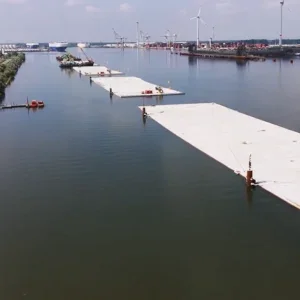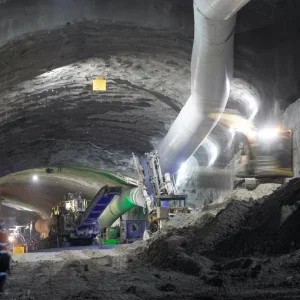Microtunnelling has got bigger, in more ways than one. If manufacturers’ terminology is anything to go by, remote-control tunnelling systems to over 3m diameter now qualify as microtunnelling systems. At the same time, the market for microtunnelling activity continues to grow worldwide, even though the majority of projects are carried out by ‘used’ or rented systems.
Genuine technical developments in microtunnelling are now comparatively rare, especially in the true (non-man-entry) range of diameters. Nevertheless, those that have been introduced can produce significant benefits for users in particular circumstances.
Makoto Kajiyama, Iseki Poly-tech’s head of research and development, recently claimed that whereas Iseki has introduced five significant microtunnelling developments in the last few years, he said he did not know of any other company that had introduced a significant system, although there had been improvements.
The use of remote-control tunnelling technology, originally developed for non-man-entry diameters, has been applied to increasingly larger diameters.
The main advantages are increased safety during operation and more pleasant working conditions. Also communication between the operational points and surface activities is made easier.
One of the continuous developments of most significance to system users is the greatly improved reliability backed up by manufacturers’ service support. In the early days of microtunnelling, it had been a general criticism of the technology that the normal risks of tunnelling were increased by reliance on a system in which the normal rectification of problems was to dig out from the surface or to bore in from another direction.
Most components are now well-proven. In addition, the development of more durable cutterheads applicable to both mixed and hard ground has decreased concerns about choosing the right cutter elements and whether they will last until the next access shaft.
Dominique Delbaere, chief engineer and head of tunnelling at Belgian contractor Denys, say, "Reliability of small shield machines is now very high. In diameters of 800-900mm id we can do drives up to 250m long at depths of up to 15m. Five years ago we didn’t do that. Also, machines are now stronger. We are not stopped by boulders or wooden piles any more. Even concrete doesn’t stop them. The drive systems are stronger, but it means the space within the shield is now completely full." To the well-proven Iseki Unclemole (TCS) design with an internal cone-crusher has been added a cutterhead capable of cutting massive rock for multi-purpose use. The same design has now been applied to diameters down to 350mm i.d. In sizes above 1500mm id it is, however, possible to reach the head from inside to change cutters. This is achieved by using a smaller cone crusher, relying on the ability of disc cutters to break up boulders to some extent before reaching the cone crusher. The reliability of this design was demonstrated by a project under the Kwang Yang river in South Korea. Kyung Dong Co installed a 1779mm od steel pipe for liquified natural gas under the river in a single drive 440m long. Boring through 120MPa rock, silt, sand and clay, the TCS 1800mm (od) completed the drive without intermediate jacking stations and without the need to change the roller cutter bits.
Herrenknecht‘s AVN slurry range includes the 1500T model design for long-distance drives in rock. Drives of over 500m are possible are the roller bits can be replaced during the drive, with compressed air working if necessary, and therefore some intermediate shafts can be eliminated. A high torque of 260kNm is beneficial especially in non-cohesive rough gravel.
The D series are small Hydroshields which are claimed to be more flexible for a wider range of soil types. A compressed air bubble in the rear chamber regulates the support pressure at the face, reacting quicker than a conventional pumped slurry system, and separating the support and spoil removal functions. The D series covers ods of 1600 to 2400mm.
Special versions of rock-handling machines have been developed by Iseki, Soltau and Herrenknecht for pipe replacement on line.
Wirth Soltau range covers pipe diameters of 150 to 3000mm and is capable of drives up to 600m long. The pipe replacement system is based on the well-proven auger-based RVS 250A microtunnelling systems for pipes of 250-600mm id and is suitable for cutting out unreinforced concrete and clayware pipes. The standard RVS 250A is capable of installing pipes of up to 1190mm od depending on the size of jacking rig selected.
The use of microtunnelling systems in urban locations has placed great emphasis on the need for small site "footprints". Apart from good house-keeping on compact storage areas, the foci of development have been the ability to work from smaller and smaller shafts, and the need for more efficient spoil handling systems.
Spoil handling and slurry recycling can be one of the biggest headaches for microtunnelling site managers, especially where there is little surface space or when a high proportion of clay and fines has to be handled. Often the problem has been addressed by contractors themselves. UK contractor, Barhale, working with Manvers Engineering, has developed a 3-storey slurry treatment plant including screens, cyclones and centrifuges to handle slurry with clay and emit spoil as a stiff mud into an adjacent skip. (T&TI May ’99). This greatly reduces the length of the "footprint" required while occupying only one side of a normal road.
Depending on the ground type, pumped spoil handling from earth-pressure balance (EPB) shields may be possible. Iseki developed a "linked" EPB system for work in Bangkok, with which spoil can be discharged whilst maintaining face stability, but without any slurry recycling.
Denys’ Delbaere says, "In mud treatment you have to have centrifuges for fine particles. There have been improvements in separating spoil from the bentonite slurry, but there wasn’t a lot to do there. Flocculating systems and pressure filters don’t usually have a large enough capacity for tunnelling. This has to be improved." Also for the unusual ground conditions in Bangkok, Wirth Soltau has manufactured shield machines which drive the face only by forward pressure, with no normal excavation device. Small-diameter earth displacement microtunnellers have also been developed by Iseki and Herrenknecht. Herrenknecht’s AVB automatic system is in ods of 425 and 665mm. Ground is displaced via a conical steering head whilst the cutterhead loosens the soil in front, with excavating it. The cutterhead can also deal with obstacles such as wood.
Herrenknecht’s range of microtunnelling systems includes both slurry and EPB types as well as the Bohrtec service connection microtunnellers which the company markets internationally. These are auger-based machines in the range 150-500mm. Automatic, steerable and non-steered operations are available. Herrenknecht EPB systems are available with winched conveyor buckets, rail-bound and dense medium pump spoil removal systems. Diameters range from 1830 to 3080mm o.d..
Urban applications are often restricted by the circuitous routes of streets as well as their narrowness, and the risk of passing near or under adjacent structures. Thus the ability to steer the shield machine around curves, preferably as tight as possible, will reduce the need for shaft construction. Accurate guidance is important for straight as well as curved drives, but recent guidance developments have greatly increased what can be achieved in terms of curves (vertical and horizontal) and drive lengths where loss of laser intensity had been a problem.
Guidance systems specialists such as VMT and ZED Instruments have developed improved methods and equipment for both man-entry and non-man-entry diameters. Together with the improved reliability of shield machine mechanical and electrical systems these are the main reasons for the achievement of curved and long-distance drives, together with the expertise of forward-thinking contractors. Dominique Delbaere of Denys told T&T International of the company’s latest achievements. In Leuven Denys it completed a 225m long sewer drive on a 300m radius curve using a 1200mm id Iseki Unclemole system. Thirty metres of the drive was under a river. At Grimburgen, near Brussels, several extended and curved sewer drives were carried out using Denys’ 1600mm id Herrenknecht, and two Iseki Unclemoles of 1000mm id and 1200mm id. Directional control was made on a VMT system using a Leica TCA1100 motorised laser theodolite. Denys’ first project with the VMT system included a 560m long S-curve of 300m radius using a 2000mm id shield machine.
Using a double articulation joint, the Iseki TCT microtunnelling systems can negotiate radii as small as 50m. In Japan, gas companies have installed steel pipes for drives up to 540m long using the TCT without interjack stations. A special lubrication system developed by Iseki has aided this work.
Guidance and steering form only one element of complete instrumentation and control packages developed by or for the main manufacturers. Facilities available from computerised control systems include semi-automatic or automatic operation or functions such as steering, thrust and face pressure balance. Specialist systems developer TMS (Tunnel Management System) has worked on a "touch-screen" control system for Euro Iseki, which it claims to be more user friendly. Multi-core control cables have been eliminated in favour of single 2- or 4-wire cables to the face machine.
Traditionally a manufacturer of pipe jacking and open shield machines, Akkerman is a comparatively recent entrant into the microtunnelling market with sytems noted particularly for an advanced, robust control system. This can be used with the full range (600-2300mm od) of sizes. The control system features distributed relays with diagnostic capabilities which allow fault areas to be identified and are said to be more relaible that hard-wire replays. The control vdu uses Windows-based menu-driven operation. Akkerman’s own guidance system features a TGS 100 active target to measure ‘X’ and ‘Y’ co-ordinates, shield machine roll, incline, and yaw while calculating the position of the shield machine.
Many utilities clients have moved to the installation of plastics pipes in smaller diameters, but the materials do not readily lend themselves to jacked installation. Recent developments, chiefly in Japan, in specialised jacking systems now allow the installation of PVC pipes with microtunnelling. Most plastics pipes are installed with auger-based mircotunnelling systems but Iseki has developed the use of small slurry systems for work below the water table. The Iseki TCZ, for example, is available for the installation of PVC pipes as small as 200mm id beneath the water-table and from a 1500mm drive shaft. Kajiyama of Iseki gives sewer service connections as a major application of the method. The first use of a slurry-shield system to install pvc was also claimed to be the smallest microtunnelling system. Nigata Hirose-Gumi used a 240mm o.d. Unclemole V to install a 46m length of 200mm id pvc pipe in Nigata Prefecture. A thrust force pipe, mounted inside the pvc product pipe, transfers the jacking load forward. and also allows the use of push-fit slurry-line connections to reduce non-productive time.
Additional equipment for the recently introduced Soltau RVS80 system includes a capability for installing HDPE pipes and blind-end pipes. The system covers pipe diameters of 150-400mm and is capable of drives of over 80m below the water-table. The process, in three stages, comprises the boring of a steerable pilot tube, followed by reaming out and installing a steel casing, followed by installation of the product pipe.







